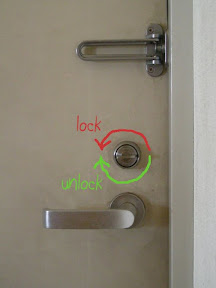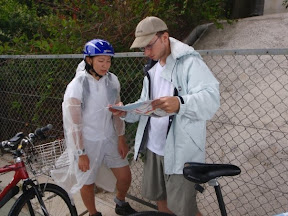Preface:
I wrote this about a trip I took in August over summer break from school. I started writing it just after I got back to Matsuyama, but the process of arranging all the detail in this post exhausted me, and I still haven’t written about the last two thirds of the trip. I think this is my longest post to date, and it only covers the first part of my trip. I hope to get to the rest very soon. 🙂
I don’t remember when I first heard about Bunny Island, but I think it was about a year ago. Then earlier this year, I read a blog post written by a JET ALT who went there in February. A month and a half later, I was happily accepting a position in Matsuyama, pretty close to the island.
Its actual name is Ohkunoshima (with the accent on the first elongated “O”). It was once home to a secret weapons plant (where they actually hid WMDs!). Many Japanese people, even from the cities nearest the island, have never heard of it.
The site itself fascinated me from the first moment I heard about it (A super secret island in the Seto Inland Sea that still has ruins of an illegal WWII-era gas plant? Oh, heck yeah!), so when I learned our school’s summer vacation was two weeks long, I figured that would be the perfect time to go.
This (excessively long) post is about the good luck, good people, and good experiences I was fortunate enough to encounter on that brief two day trip.
***
8/8/08
When I woke up late two days ago, I knew I’d have to rush to make the 10am bus. I’d already skipped a day in my plans to go to Ohkunoshima because I wasn’t yet ready to leave. (I wanted to buy a book for the trip, but the bookstore was closed by the time I decided. A lame excuse, especially since I didn’t end up reading it, but I wanted an extra day to relax anyway.) So I scrambled to get ready and get out the door at about 9:40 for the fifteen minute ride to the city station.
I added my bike to the hordes of bicycles already gathered and concentrated like so many lengths of tangled Christmas tree lights, and briskly walked back to the empty platform where my bus would soon be. Relieved that I’d made it in time, I used my five minute buffer to go inside the station and ask again whether or not I needed to buy a ticket before boarding the bus. As you might imagine, I don’t always know if I’m getting good information when I speak to people in Japan. Usually we speak in a mixed form of “Japanglish,†so I’m never sure if my takeaway message is exactly what they meant, and I wanted to be absolutely certain that I could get on the bus without a ticket. I got confirmation that the fare was determined and payment collected upon leaving the bus.
Relieved, I went back outside to see that my bus had just divested its passengers and was boarding to leave in about thirty seconds. I stepped on with a confused look on my face and the driver smiled and pointed to the ticket dispenser on my right. “Take ticket,†he said, his meaning already clear. I took a ticket labeled “0,†and wondered what it meant.
I’m not sure what I expected, but I think I was the fourth person to get on the full size touring coach at that terminus, and I was surprised to see the bus as empty as it was. The bus was pretty nice, with deep red velour seats, and actual curtains on the windows. Another thing that surprised me was the fifth foldaway “jumper†seat in the aisle of every row, whose use would completely block the exit for passengers behind that row. Different safety standards for different countries, I suppose.
The bus left as soon as I sat down. We had one more stop in Matsuyama, where I realized that oncoming passengers were collecting tickets labeled “1.†At that point I figured out the price board above the driver’s head and the pricing based on how far you’d ridden, and understood why my ticket was labeled “0.â€
I took a few moments to finally relax and let some of the dampness evaporate out of my shirt. Even though it was still early morning, I’d ridden pretty hard to get to the station on time, stopping once to put the chain back on Rusty’s rear sprocket. He gets crotchety when I ride in a spirited manner. The air conditioner on the bus was adequate, but nothing spectacular. A nice touch was the adjustable automobile-style vents placed above each seat, which I directed at my back. This was my first long-distance trip since I started working in Japan, and I saw some of Matsuyama that I hadn’t seen before, so I took a few pictures of the city as we passed.












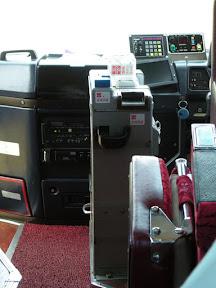
Every time I mention wanting to go to a beach in Matsuyama, people tell me to go to Hojo (a town on the northern outskirts of Matsuyama) instead of Matuyama’s beaches, so I was delighted to see the bus stop right at a beach complex in Hojo. After that, civilization thinned out until it was just a highway rest stop / beach restaurant every mile or two. Even that held my interest though, as I think Japan has some very interesting geometric artificial breakwater blocks, and the restaurants and small populated coves are fascinating.
Civilization started picking back up as we approached Imabari, a small city on the northern tip of Shikoku (the Japanese island on which Matsuyama is located). The outskirts seem very depressed, and reminded me a lot of the images you see when the US evening news talks about Detroit. Downtown Imabari was another story though, and reminded me very much of a small California coastal city. There was a rest stop and driver change in Imabari, and with the bus door left open for a few minutes, you could smell the sea air and see the boats slowly bobbing in the docks, only a hundred yards away from the bus station. Even passing through for as short a time as we did, I got the impression that life travels a little slower there.
We were back on the road in short order, heading northeast toward the series of bridges and islands that connect Shikoku with Honshu (the biggest of the four main islands). There was a lot to see on the way, and I felt like a total tourist, snapping pictures of anything that caught my eye. I gave myself permission to play tourist for a while, disregarding the mild amount of attention it brought the only gaikokujin on a slowly-filling bus. I half expected someone to remind me that I wasn’t on a tour bus.
At each stop, I checked the kanji on my bus schedule with the kanji on the board at the front announcing the next stop, and (when I could understand it) the “next stop is …†announcements from the speakers in the bus. I felt a little tension growing as my stop approached, because I really didn’t have a plan for what to do once I got off the bus, but I tried to relax and enjoy my first trip through the real Japanese countryside.
When it came up though, it was easy to spot, letting off in a large bus turnaround area with a few bus stops around the perimeter.




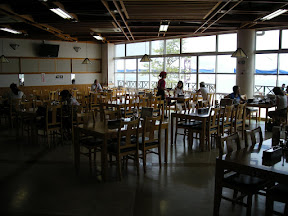
From my bus stop, I didn’t know where to go for the ferry I needed, or how I would get there if it was too far to walk. Just looking at a map, the bus stop seemed to be a tiny outpost next to one of the bridges, and that turned out to be about right. The area around the bus stop has a highway rest stop and a small collection of highway trap businesses, including a restaurant, a gift shop, a small convenience store, and (thank the gods) a bicycle rental shop.
I took a few pictures of the scenery, ate a lunch of octopus tempura and udon at the restaurant, and set about finding information on the ferry I needed to catch. I first asked the waitress at the restaurant where I needed to go to catch the ferry, and she told me the name of the town I needed to get to. Having never heard the name and finding it quite a mouthful, I promptly forgot it, but she walked me next door to the convenience store and handed me a ferry schedule with the town’s name on it. She exchanged a few words with the convenience store clerk, and both ladies said something to me in Japanese I didn’t understand at all. Through a few iterations of smiles and language retries, they told me I should go next door and rent a bicycle.
I later learned the bicycle rental shop caters to people who rent bikes to ride across all the bridges between Honshu and Shikoku- an understandably popular attraction in that gorgeous countryside, especially for someone who likes bridges as much as I do. The area is a mix of different types of classical Japanese scenery, with little wooded rocky island hills popping up out of the sea and Japanese people wearing classic kasa (those stereotypical wide, flat, cone-shaped hats) while working terraced rice paddies alongside the most modern and impressive of bridges. If you have any interest in bridges or modern architecture, it seems like riding the island highway would be a fantastic way to spend a few days, as most of the bridges are constructed in different styles, and the sea breezes are refreshing even on the early August days I was there.
The young lady at the bicycle shop was quite helpful, providing me with a map of the island we were on (Ohmishima) and a brochure for the bridges-by-bicycle tour I mentioned. I plunked down my ¥1500 (~$15.00), signed on the line, and rode away on one of their cruisers.
I had about an hour to ride the three miles from the bicycle rental shop to the ferry landing, an easy cruise up the coast of the island. It’s been so long since I’ve been to the beach, I just wanted to take big heaping lungfuls the sea air. I could feel my lungs thanking me.
Now, as near as I could understand her, the woman told me to ride up the main road until I got to the ferry port. I hit a bit of a snag though, when the main road veered away from the coast. Straight ahead was a small road, barely wide enough for two cars to slowly pass each other. Thinking that couldn’t be the way I needed to go, and that the road must just be temporarily veering around some coastal feature I couldn’t see, I followed the main road as it turned inland, not suspecting I’d just turned away from the road I needed.




I passed a very small local beach and made it to the ferry dock with only a few minutes to spare. Looking around, I realized that I didn’t see another bicycle rental shop to which I should return my bike, so I stopped to ask a man if there was a bicycle rental shop in the dock area. He was already getting out the paperwork to check my bike back in when I realized this guy had been working in the office where I had just rented the bike an hour ago. He gave me back a ¥1000 (~$10.00) deposit I hadn’t even realized was two thirds of the cost of the rental and collected a copy of my rental form. He loaded the bicycle in the back of a small van, and turned on the road to go back to the main office. This guy had just driven from the main office specifically to collect my bike at this small town.
Smiling and amazed at their “system†for collecting bicycles (so that’s why she asked where I was going), I went inside to buy a ticket for the ferry. It was at this point that I realized I was really moving down the food chain of Japanese cities. Matsuyama is not a metropolis, but it’s definitely a medium-sized city. The bus passed through smaller Imabari to drop me at the tiny tourist-driven whistle-stop where I rented the bike. Then I turned off that main road and ended up at the ferry dock that was supposed to take me to Ohkunoshima. I didn’t even see anything that I’d call a town- it was just a dozen buildings lining the waterfront across the street from the dock. I presume the town’s handful of employees all live in one of the rice farms and small orchards I passed along the road.


On the upside, the bike path that parallels that highway is absolutely gorgeous. That’s one thing I’ll say for Japanese civil engineers- they build a killer bike path. A few hundred yards away from the coast, I realized the highway was heading into the foothills, and didn’t seem likely to turn back and follow the coast. I stopped and asked a road construction worker where we were. As I feared, he pointed to the highway I was hoping he wouldn’t say we were on. I checked my watch and turned around, careful to choose the driveway I’d previously avoided.
As soon as I got back outside, the ferry started loading passengers. I was surprised to see that it was a full size ferry with space for cars on the lower deck and a couple hundred seats on the upper level. The trip to the actual island was basically an uneventful ferry ride, which gave me time to enjoy the Engrish on display. I got a little concerned when I started thinking about the fact that I didn’t have a reservation at the only hotel on the island. I figured the worst case scenario would be me spending a night on the beach leaned up against my backpack.
But hey, I brought a towel (thank you, Douglas Adams), so I was prepared for just about anything.
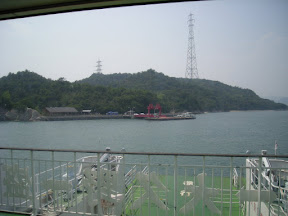
***
To be continued
Pictured on the left is a wall plate of five Japanese light switches. They’re always mounted to switch horizontally (as opposed to vertically in the US). The little oval mark is the “on” position, which always seems to be on the right. The bottom two switches are for vent fans (I took this picture in a commercial kitchen), which when switched on, are backlit by a red light.
